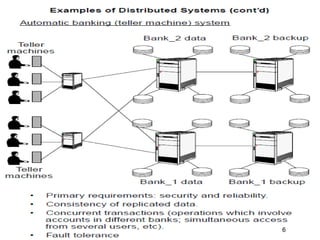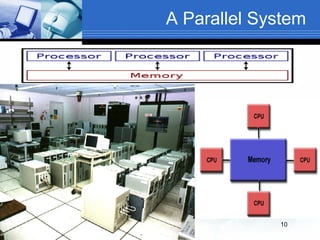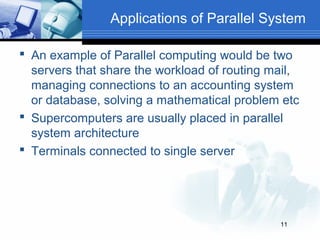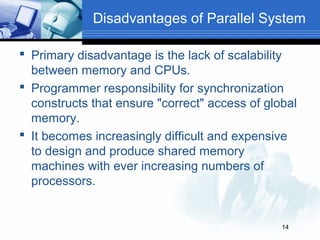Distributed & parallel system
- 1. Distributed And Parallel System m Company LOGO 1
- 2. Contents 1. Definition of Distributed System 1. Definition of Distributed System 2. Examples/Application of Distributed System 2. Examples/Application of Distributed System 3. Advantage and Disadvantages of Distributed System 3. Advantage and Disadvantages of Distributed System 4. Definition Of Parallel System 4. Definition Of Parallel System 5. Examples/Applications of Parallel System 5. Examples/Applications of Parallel System 6. Advantages and Disadvantages of Parallel System 6. Advantages and Disadvantages of Parallel System 7. References/Sources 7. References/Sources
- 3. DEFINITION A distributed system is a collection of independent computers, interconnected via a network, capable of collaborating on a task. A distributed system can be characterized as collection of multiple autonomous computers that communicate over a communication network and having following features: No common Physical clock Enhanced Reliability Increased performance/cost ratio Access to geographically remote data and resources Scalability 3
- 4. A Distributed System 4
- 5. Examples of Distributed System Telephone Networks and Cellular Networks Computer Networks Such as internet or intranet ATM(bank) Machines Distributed database and distributed database management system Network of Workstations Mobile Computing etc. 5
- 6. 6
- 7. Advantages Of Distributed System Information Sharing among Distributed Users Resource Sharing Extensibility and Incremental growth Shorter Response Time and Higher Output Higher Reliability Better Flexibility’s in meeting User’s needs Better price/performance ratio Scalability Transparency 7
- 8. Disadvantages of Distributed System Difficulties of developing distributed software Networking Problem Security Problems Performance Openness Reliability and Fault Tolerance 8
- 9. DEFINITION A system is said to be a Parallel System in which multiple processor have direct access to shared memory which forms a common address space. Usually tightly-coupled system are referred to as Parallel System. In these systems, there is a single system wide primary memory (address space) that is shared by all the processors. On the other hand Distributed System are loosely-coupled system. Parallel computing is the use of two or more processors (cores, computers) in combination to solve a single problem. 9
- 10. A Parallel System 10
- 11. Applications of Parallel System An example of Parallel computing would be two servers that share the workload of routing mail, managing connections to an accounting system or database, solving a mathematical problem etc Supercomputers are usually placed in parallel system architecture Terminals connected to single server 11
- 12. EXAMPLE: The Earth Simulator Supercomputer from (2002-2004) 12
- 13. Advantages of Parallel System Provide Concurrency(do multiple things at the same time) Taking advantage of non-local resources Cost Savings Overcoming memory constraints Save time and money Global address space provides a user-friendly programming perspective to memory 13
- 14. Disadvantages of Parallel System Primary disadvantage is the lack of scalability between memory and CPUs. Programmer responsibility for synchronization constructs that ensure "correct" access of global memory. It becomes increasingly difficult and expensive to design and produce shared memory machines with ever increasing numbers of processors. 14
- 15. Parallel vs. Distributed System Parallel Systems Distributed Systems Memory Tightly coupled system Weakly coupled system shared memory Distributed memory Control Global clock control No global clock control Processor Order of Tbps Order of Gbps interconnection Main focus Performance Performance(cost and scalability) Scientific computing Reliability/availability Information/resource sharing 15
- 16. Sources / References Websites en.wikipedia.org books.google.com www.seminarprojects.com http://publib.boulder.ibm.com www.webopedia.com https://computing.llnl.gov/tutorials www.cis.upenn.edu Books Distributed System by Coulouris Distributed Computing by Ajay D. Kshemkalyani,Mukesh Singhal 16
- 17. Thank You Presented by: Manish Ranjan Singh BVDU, IMED, Pune MBA (General)
Editor's Notes
- #2: 1

















